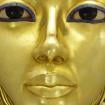
Dazzling Nebmaatre: Sunset in Waset—Part III
The efflorescent era of Amenhotep III ushered in a period of unsurpassed prosperity for Egypt. During this time, the country grew economically and militarily powerful. But the Sun was bound to set on this age of empire – and it did – when Pharaoh “joined the gods” after a memorable reign. It was the end of the epoch of ostentation.
Read Parts I and II of the series here:
Dazzling Nebmaatre: Amenhotep III and the Age of Opulence—Part I
Dazzling Nebmaatre: Queen Tiye, the Matchless Matriarch—Part II
MOVE TO MALQATA
In Regnal Year 29 Amenhotep III shifted his court to the breathtakingly beautiful mud brick palace city of Malqata (Per Hai, “House of Rejoicing”) on the West Bank in Thebes (Waset); which was discovered by George Daressy in 1888. The king lent his own special touch and named the vast royal residence ‘The House of Nebmaatre as Aten's Splendor’.

This limestone statue of Amenhotep III originally stood within his mortuary temple in western Thebes. (Photo: Leslie D. Black)
The huge estate spread over 80 acres (33 hectares) included chapels, audience halls, parade grounds, villas, offices and workshops. The cynosure of all eyes, reveals the fifth commemorative scarab, was the astounding pleasure lake that Amenhotep dug in Queen Tiye’s honor in Year 11. “The lake was huge - just over a mile long and about a quarter of a mile wide... The king and queen celebrated the opening of the lake by sailing on it in the royal barge named ‘The Aten Gleams’ — an interesting name in relation to his son Akhenaten's later religious beliefs,” writes Peter Clayton.
A team of experts from the Institute of Egyptology, Waseda University (Tokyo, Japan) – that had been actively engaged in fieldwork in Egypt from 1966 – undertook a comprehensive excavation of Malqata palace and brought to light a series of wall murals, painted pavements, ceilings and inlays. The details of those who ensured the continued pomp of Amenhotep’s rule, such as chief architect and Pharaoh’s namesake Amenhotep ‘Son of Hapu’, are well-attested; and many officials carved sumptuous tombs with gorgeous paintings, reliefs and commissioned elegant statues of themselves.

This collage of excavated painted fragments shows the wealth of decorations at the famed Malqata palace in Thebes.
Amenhotep’s desire to better the existent grandiose repository of architecture is evident from a stele at Thebes, in which he proclaims his accomplishments and vows to construct monuments “... the like of which never existed before since the primeval time of the Two Lands.”
EDIFICES TO HIS GLORY
Amenhotep III was a builder nonpareil; shining examples are the two towering quartzite sandstone “Colossi”—known to us after the Trojan War hero Memnon—that depict the enthroned pharaoh in the first pylon of the “Temple of Millions of Years”. The monarch desired that the statues should “gleam into people’s eyes like the rising Aten”. According to Richard Wilkinson, “These colossi… showed the inseparable relationship of the king with the gods at a level close to that of the divine.”

Rear view of the Colossi of Memnon: the towering 65-foot high quartzite sandstone statues that depict Amenhotep III at Kom el-Hetan, near Luxor. (Photo: Heidi Kontkanen)
The mortuary temple was the jewel in Amenhotep’s crown. Even the Ramesseum and Medinet Habu paled in comparison. Sadly, it was plundered for building materials within a few decades of its construction and was exposed to the vagaries of nature thereafter.
Amenhotep’s other noteworthy architectural projects were effected in the Temple of Karnak (Ipet-sut, “most select/sacred of places”) dedicated to the Theban triad of Amun, Mut and Khonsu. The Colonnade of Amenhotep III in Luxor is an exemplar of refined design. Some Egyptologists opine that the courtyard beyond the Colonnade, the so-called “Great Sun Court” was a precursor to Akhenaten’s open-air Aten temples. The pharaoh also built the Third Pylon at the Temple of Karnak and began work on the Hypostyle Hall.

The elegant columns of the ‘Great Sun Court’ at Luxor Temple. (Photo: Heidi Kontkanen)
Amenhotep erected a large number of Sekhmet statues in the precincts of the Temple of Mut in Karnak. An estimated 600 sculptures of the feline goddess have been discovered over the years.
This FREE PREVIEW is just a taste of the great benefits you can find at Ancient Origins Premium.
Join us there ( with easy, instant access ) and reap the rewards: NO MORE ADS, NO POPUPS, GET FREE eBOOKS, JOIN WEBINARS, EXPEDITIONS, WIN GIFT GIVEAWAYS & more!
- Daughter of Disaster: Unsung Ankhesenamun
- The Twin Tragedy of Tutankhamun: Death of a Dynasty
- Enigma of the Heartless Pharaoh: Who Stole the Heart of King Tut, and Why?
- Curse of the Buried Pearl: Tomb Curses, Spirits and the Hunt for Ancient Treasures – Part I
Top Image: The 14 columns of the The Colonnade of Amenhotep III - Luxor Temple (CC BY 2.0) and Statue of the Pharaoh (CC BY 2.0), Deriv.
By Anand Balaji















